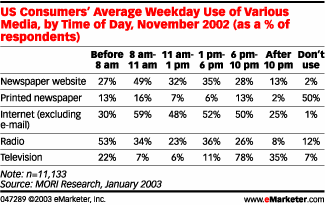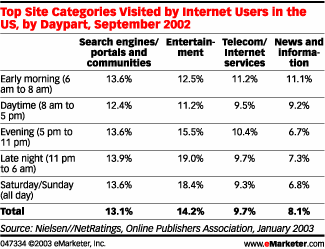Online adverteren op specifieke dagdelen

De laatste buzz in online advertising is adverteren op specifieke dagdelen. David Hallerman van eMarketer heeft hierover vandaag een aardig reviewartikel.
The method of online advertising currently receiving some justifiable buzz is dayparts. David Hallerman reviews the latest reports regarding online dayparts and reports that even though the option is not yet popular, it certainly has potential.
In the world of magazines, editors embed the term “TK” into unfinished documents to designate something “to come.” In the world of advertising, online advocates use the term “dayparts” as a beacon promising better targeting for advertisers, more profits for publishers, and a maturation of the industry as a whole.
The concept of dayparts is simple: ads pegged to the time of day and day of the week. The ostensible purpose of dayparts is to reach the right folks when they are most open to the advertisements. In fact, dayparts are old hat in TV-land, where it’s called primetime. For the Internet, the daypart notion has been getting both attention and support from several surveys released in the past few months.
That the Internet may be the preeminent place to reach people during the day comes clear from data such as the following chart from MORI Research’s study done for the Newspaper Association of America. In all three mid-day and early evening time slots?from 8 am through 6 pm?US consumers use the Internet more than radio, TV or newspapers.

Further research in the report, dramatically entitled “Online Dayparting: Claiming the Day, Seizing the Night,” indicates that while TV marketing most influences consumer purchase decisions (at 46% of respondents), the Internet is not far behind (at 37%). Actually, the research shows the Internet as a greater influencer than traditional media such as radio and magazines.
On the heels of the MORI Research report, the Online Publishers Association came out with a white paper called “The Existence and Characteristics of Dayparts on the Internet.” Supported by research from Nielsen//NetRatings, this report looks to prove that from 8 am to 5 pm, Monday through Friday, the Internet is one of the principal media.
For example, the study compares cumulative reach?defined as the total daily unduplicated audience by daypart?between the Internet and television. It appears that online’s cume reach during the daytime hours is 62% of TV’s reach. “It is important to recognize, however,” the OPA writes, “that as of this writing the Internet reaches only about 60% of the total US population.”
One of the more interesting slices of data in the OPA study indicates that the top Web site category during the daytime daypart may not be news and information?as some industry observers seem to believe. Instead, search engines and portals lead the pack, at 12.4% of US Internet users, followed closely by entertainment at 11.2%.

However, just as the magazine editor’s “TK” designation tags holes that still need to be filled, the Internet’s dayparts remain more promise than reality. Recent research from DoubleClick found that online advertisers now target about 42% of all ads. However, the most popular targeting scheme is keyword/content, at 81% of targeted ads. Targeting by time of day remains relatively rare, reaching only 1% of ads.

Even that low figure is no reason online dayparting’s champions should be discouraged. As Clark Kokich, president of Avenue A, recently told eMarketer, “2003 is the year of dayparting tests. But more and more advertisers are discovering that dayparting works.”
Bron:
Plaats reactie
Je moet ingelogd zijn op om een reactie te plaatsen.